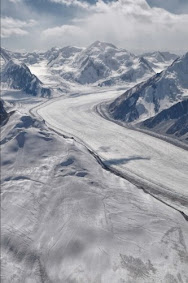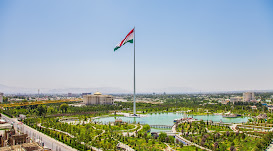I started a 50-week series in 2019 that I called Travel the World. Each week of the series I visited a randomly-selected country, sharing bits of information about that country. I then chose one tidbit of information about that week's country as inspiration for a card. As I explored those 50 countries in 2019, I knew I would continue on until I've visited every one of the 195 countries in the world, so I continued the series in 2020 and here I am in 2021, the third year of traveling the world.
This week's country is...
Tajikistan
Tajikistan is a mountainous landlocked country in Central Asia. It is bordered by Uzbekistan to the north and west, Kyrgyzstan to the north, China to the east and Afghanistan to the south.
Tajikistan is separated from Pakistan by only a small strip of land known as the Wakhan Corridor. It is a narrow strip of land present in Afghanistan between the mountains of Karakoram Range and the Pamir Range. It has a length of 220 miles but a width of around 8 miles to 40 miles at different points.
A former member of the Soviet Union, Tajikistan gained independence in 1991.
It is the 94th largest country in the world by area with 55,250 square miles.
Geographically, the country is slightly larger than England. Its entire population is the same as the city of London.
An interesting fact about Tajikistan is the name of its capital, Dushanbe. It is a word of Tajik language meaning Monday in English. This name was given to the capital of the country because in history, it used to be a village that hosted a very popular market every Monday. This weekly market played an essential role in the development of the city. As of today, Dushanbe is the largest city in the country.
More than 90% of the country is covered with mountainous ranges and about 50% of the country has an elevation of more than 9,800 feet above sea level.
Tajikistan's mountains provide opportunities for outdoor sports, such as mountain biking, skiing, snowboarding, and mountain climbing.
Being a mountainous country, it has one of the longest glaciers in the world. The Fedchenko Glacier, located in the Yazgulem Range of the Pamir Mountains, is the longest glacier in the country. This glacier has the honor of being the longest glacier in the world outside the Polar regions. It has a total length of around 48 miles.
Much of Tajikistan is unsuitable for human habitation, mainly due to its altitude, however, there are some desert and semidesert areas of land that are suitable for irrigated farming, gardens and plantations.
About 50% of theTajikistan labor force works in agriculture.
There are about 1450 lakes in the country.
The most popular and beautiful lake of Tajikistan is Iskanderkul. This triangular shaped lake is located at an elevation of 7,200 feet. Moreover, according to a legend, Alexander the Great stopped by this lake, and so the lake was named in his honor (his Persian name was Iskander).
Tajikistan is home to the world’s second tallest dam. The Nurek Dam (984 feet) is located on the Vakhsh River in Tajikistan and was built to generate hydroelectricity.
Tajikistan grows grains, cotton, fruits and vegetables and rears cattle, sheep and goats.
Its industry consists of aluminum, lead, zinc, chemicals and fertilizers.
Tajikistan also exports aluminum, cotton, electricity, fruits, vegetable oil and textiles.
Tajikistan is home to the world’s second-highest road, the Pamir Highway. Also known as the M41, the Pamir Highway is renowned for its spectacular scenery and remote route.
The Silk Road, an ancient network of trade routes passes through Tajikistan.
Unibrows are considered highly attractive in the country and the girls who have separate eyebrows often paint them to create an illusion.
They have more than 5,000 kinds of flowers, and its animal life is both abundant and diverse, there are gray lizards, wildcats, golden eagles and brown bears, and they are all very unique to this area.
The country lies in a sensitive seismic zone, and every year the country faces 5000 deep and shallow earthquakes.
Tajikistan has the world’s second-tallest flagpole. The Dushanbe Flagpole is over 540 feet tall.
Villagers in the mountains of Tajikistan used to dupe visitors into looking for Yetis (or “Abominable Snowmen”). Villages would have a designated ‘Yeti witness’ whose job was to guide visitors to remote valleys where sightings were supposedly taking place and charge them a fee for the service.
Tajikistan’s national sport is gushtingiri, a form of traditional wrestling. Traditionally, towns were divided into mahallas (districts) and each district had its own alufta (tough) who was the best wrestler.
The winter sport of Buzkashi is also played in Tajikistan. Played on horseback, the game originates in Persia and is similar to polo. The aim is to scoop up a dead carcass (usually a goat) and land it in a goal.
People from Tajikistan are very hospitable, and guests will not be able to say goodbye to them without receiving gifts from them. From handcrafted souvenirs made with ceramics, wood and even glass, to patterned fabrics, Tajik people are very proud of what they are able to create with their hands. This is why they will make sure guests never forget them nor their country, and they will giving their work as a present.
Hospitality, humility, and respect are considered essential for successful interaction in the culture. The elderly are always given the place of honor. A man must never enter a home where there are only women, and a girl must never be left alone with a boy. At large social gatherings, men and women often are separated. Everyone stands when another guest enters. When shaking hands in greeting, it is a demonstration of good manners and respect to place the left hand over the heart and bow slightly.
Women founded a classical national dance that has become a feature of family celebrations and festivities. The dances begin slowly, becoming faster and more intense as they progress. The movements are harmonious and subtle, and the costumes colorful and bright. The performers dance according to the emotions of the moment.
Personal space is not respected in either private or public places.
When cultural rules are violated, gossip or ostracism may result.
The national drink of Tajikistan is green tea.
Plov (pilaf), also called osh, is the national dish in Tajikistan. It is a rice dish made with shredded yellow turnip or carrot, and pieces of meat, all fried together in vegetable oil or mutton fat in a special qazan (a wok-shaped cauldron) over an open flame.
Mealtime in Tajikistan usually begins with a small serving of dried fruits or nuts. The second course is often a serving of soup or meat and the final course in a traditional meal is the previously mentioned plov.
Restaurants usually offer Western and Russian food, and choihonas (teahouses) serve traditional foods. Guests often sit on a platform with a low table surrounded by thin mats.
Because he takes responsibility for his parents in their old age, the youngest son is traditionally the heir to family property.
The personal belongings of the mother-in-law go to the wife of the youngest son.
Parents will try to provide a house for each of their sons to improve their prospects of marrying women from a higher economic class.
Because a baby is thought to be subject to infection, it cannot be shown until forty days after it is born, when a cradle ceremony with a feast may be celebrated. This may include a coming of age ceremony for the mother, who is not considered a woman until she gives birth to a child.
The literacy rate in Tajikistan is high even though they people live in poverty. Almost 99.5 percent of the people can read and write.
My inspiration for this week's card is based on this fact about Tajikistan... a country where rural people depend almost entirely on what they produce themselves. Seventy-five percent of households grow food for their own use, with people in the cities planting gardens in vacant lots.
Thanks for stopping by my blog today!
Stamp Set: Polkadoodles Gnome Grown stamped with Memento Tuxedo Black Ink and colored with Copic Markers
Paper: Fun Stampers Journey Lemon Drop and Neenah 110# Solar White CS and DP from my scrap file
Dies: MFT Stitched Rectangles
Embellishments: SU Ribbon













.jpg)














3 comments:
Again I have learnt a lot from your world tour Jeanette - thank you. Loving that cute card - that is one large carrot your gnome is pulling :)
Stay safe
Blessings
Maxine
Wow wow wow Jeanette. Well done. Love the little gnome and the wonderful insight you have provided.
Such an adorable card!! Wishing I had learned to be a gardener!
Post a Comment